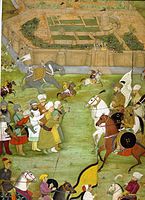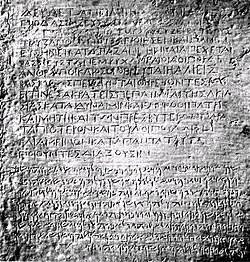Old Kandahar
Old Kandahar (locally known as Zorr Shaar;
.The citadel
It is widely believed that after conquering
The city was often fought over by the Safavids and the Mughals until 1709, when Mirwais Hotak made the region an independent kingdom and turned Kandahar into the capital of the Hotak dynasty. The city was destroyed by Nader Shah in 1738 after defeating Hussain Hotak, the last Hotak ruler. After the destruction of this old city all the remaining inhabitants were relocated to a nearby area which became known as "Naderabad" for a short time, named after Nader Shah. By 1750, Ahmad Shah Durrani had laid out the current city of Kandahar and turned it into the capital of his Durrani Empire.[6]
-
Plan of the citadel. This destroyed fortress is still standing today.
-
A miniature from Padshahnama depicting the surrender of the Safavids in 1638 to the Mughal army of Shah Jahan commanded by Kilij Khan.
-
An 1881 photo showing the ruined Old KandaharNader Shah Afsharin 1738.
-
The citadel in 2018.
Epigraphical discoveries
Important inscriptions in Greek, dating to the 3rd-2nd century BC were discovered in or around the site of Old Kandahar, including the Kandahar Greek Edicts of Ashoka, the Kandahar Bilingual Rock Inscription also from the time of the Indian ruler Ashoka, and the Kandahar Sophytos Inscription.
See also
References
- ISBN 978-1-4008-5891-0.
- ^ Lendering, Jona. "Alexandria in Arachosia". LIVIUS – Articles on Ancient History. Archived from the original on June 15, 2010. Retrieved March 4, 2012.
- ^ Dupree, Nancy Hatch (1971) "Sites in Perspective (Chapter 3)" An Historical Guide To Afghanistan Afghan Tourist Organization, Kabul.]
- ^ "Old Kandahar: An Archaeological Reappraisal". whitelevy.fas.harvard.edu. Harvard University.
- ^ Mentioned in Bopearachchi, "Monnaies Greco-Bactriennes et Indo-Grecques", p52. Original text in paragraph 19 of Parthian stations
- ^ "AN OUTLINE OF THE HISTORY OF PERSIA DURING THE LAST TWO CENTURIES (A.D. 1722-1922)". Edward Granville Browne. London: Packard Humanities Institute. p. 31. Retrieved 2010-09-24.
External links
![]() Media related to Old Kandahar at Wikimedia Commons
Media related to Old Kandahar at Wikimedia Commons
- The current situation of 2300 years historical Naranj palace Kandahar on YouTube(a short documentary in Pashto language)











